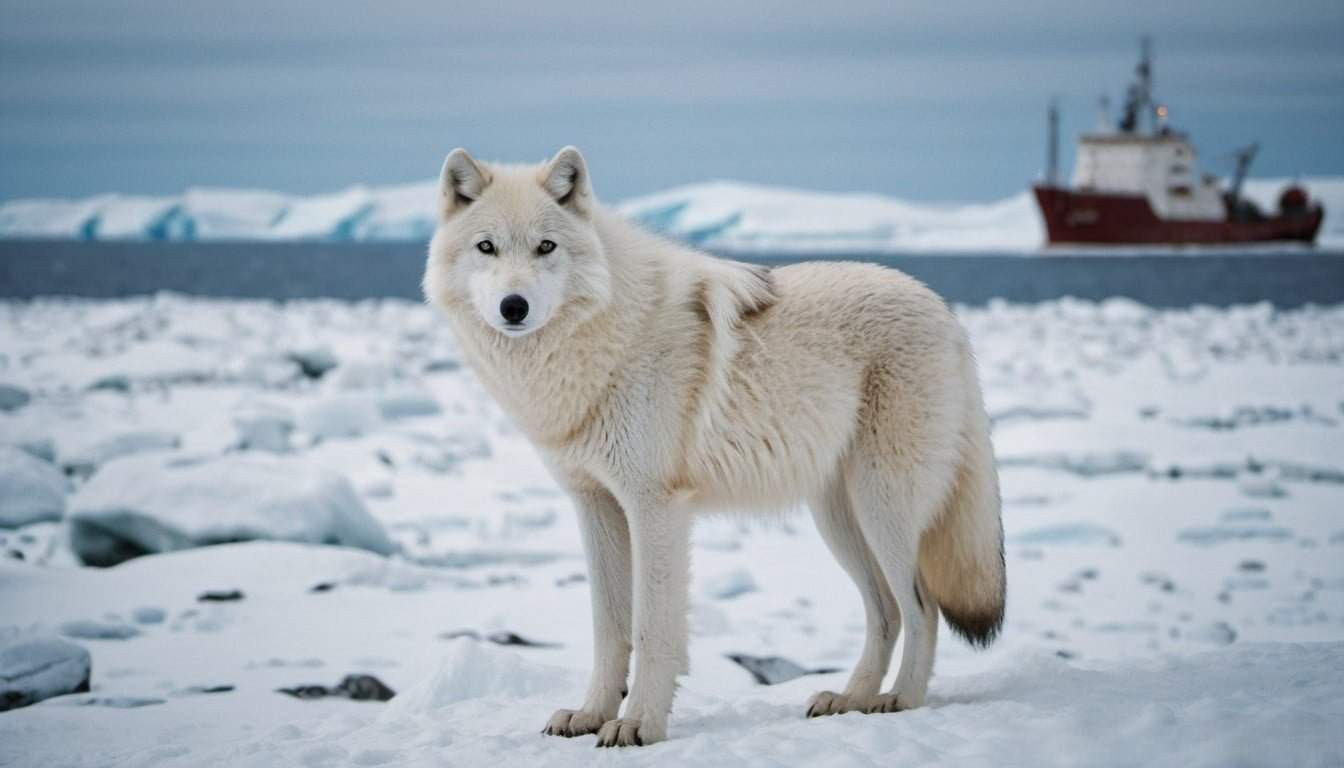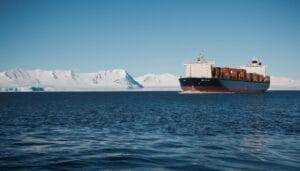Introduction
Industrial fishing activities have a significant impact on Arctic wolves’ food sources, affecting their diet and survival
This article explores the depletion of key fish species, the effects on the Arctic ecosystem, and changes in wolf behavior. We also examine the role of climate change, regulatory measures, conservation efforts, and the long-term effects on Arctic wolf populations
Impact of Industrial Fishing and Environmental Factors on Arctic Wolves’ Food Sources
Industrial fishing and environmental factors such as climate change play critical roles in shaping the food sources of Arctic wolves. Understanding these impacts is essential to grasp the challenges these predators face in their harsh environment
Depletion of Key Fish Species
Arctic wolves rely on a diverse diet that includes fish, which is crucial for their survival, especially during the harsher months when other food sources are scarce
Industrial fishing often targets large quantities of fish, leading to a significant decline in the populations of species such as Arctic char, salmon, and other cold-water fish. These species form a substantial part of the diet for Arctic wolves and other predators
The intensive fishing practices reduce the availability of these key fish species, forcing Arctic wolves to expend more energy and travel greater distances to find sufficient food. This not only affects their physical condition but also their reproductive success, as malnutrition can lead to lower birth rates and higher infant mortality
Effects on Arctic Ecosystem
The Arctic ecosystem is highly interconnected, and the depletion of fish stocks due to industrial fishing can have cascading effects throughout the food web. Fish play a vital role in the Arctic marine ecosystem, serving as prey for various animals, including seals, birds, and Arctic wolves
When fish populations decline, it disrupts the balance of the ecosystem, affecting the availability of prey for these predators
Overfishing can also lead to changes in the behavior and population dynamics of other marine species. For instance, seals and other marine mammals might also face food shortages, leading to increased competition with Arctic wolves for remaining resources. This increased competition can result in more aggressive behaviors and conflicts between species
Changes in Arctic Wolf Behavior
As their primary food sources become scarce, Arctic wolves are forced to adapt their behavior to survive. They may shift their hunting patterns, relying more on land-based prey such as musk oxen and caribou
However, these land-based prey can be more challenging to hunt and are not as plentiful as fish, leading to higher risks during hunting expeditions
The scarcity of food can also lead to increased territorial disputes among wolf packs. With limited resources, wolves may expand their territories or encroach on the territories of other packs, leading to conflicts and sometimes fatal encounters
Additionally, wolves may have to travel further distances in search of food, which can increase their exposure to environmental hazards and reduce their overall energy efficiency
Climate Change Impacts
Climate change exacerbates the challenges posed by industrial fishing. Warming temperatures and melting ice affect the distribution and abundance of fish species in the Arctic. Some fish species may migrate to colder waters, further reducing the food available to Arctic wolves
Additionally, changes in sea ice patterns impact the hunting and migration behaviors of marine mammals, indirectly affecting the food web
Warmer temperatures also alter the breeding cycles and habitat conditions for various species. For example, earlier ice melt can lead to mismatches in the availability of prey during crucial breeding periods for Arctic wolves. This can result in lower pup survival rates and a decline in wolf populations over time
Combined Effects with Industrial Fishing
The combination of industrial fishing and climate change creates a compounded effect that severely impacts Arctic wolves
The simultaneous decline in fish populations due to overfishing and shifts in species distributions caused by climate change make it increasingly difficult for wolves to find adequate food. This dual pressure threatens their survival and the stability of the entire Arctic ecosystem
Future Projections
If current trends continue, the future for Arctic wolves and their food sources looks bleak. Continued overfishing and the accelerating impacts of climate change could lead to further reductions in key fish populations. This would force Arctic wolves to rely even more on less reliable and harder-to-catch prey, putting additional stress on their populations
Conservation efforts and sustainable fishing practices are essential to mitigate these impacts. Protecting critical habitats, enforcing stricter fishing regulations, and addressing climate change are necessary steps to ensure the survival of Arctic wolves and the preservation of the Arctic ecosystem
Regulatory Measures, Conservation Efforts, and Long-term Effects
In response to the pressing threats posed by industrial fishing and climate change, regulatory measures and conservation efforts are being implemented to protect Arctic wolves and their food sources
Understanding these strategies and their long-term effects is crucial for preserving the Arctic ecosystem
Existing Regulations
Several regulations have been put in place to mitigate the impact of industrial fishing on Arctic wildlife
International agreements, such as the Convention for the Conservation of Antarctic Marine Living Resources (CCAMLR), aim to manage fish stocks sustainably and protect the marine ecosystem. Specific quotas and restrictions on fishing practices help ensure that fish populations remain stable and do not decline to critical levels
National policies in Arctic countries, like Canada, Russia, and Norway, also play a vital role in regulating fishing activities. These regulations often include establishing marine protected areas (MPAs) where fishing is restricted or prohibited, allowing fish populations to recover and thrive
Enforcement of these regulations is essential to prevent illegal, unreported, and unregulated (IUU) fishing, which poses a significant threat to marine life
Conservation Strategies
Conservation organizations and researchers are actively working to protect Arctic wolves and their habitat. Efforts include monitoring wolf populations, studying their diet and behavior, and identifying critical habitats that need protection
Public awareness campaigns highlight the importance of preserving Arctic ecosystems and the impact of industrial activities on wildlife
Habitat restoration projects aim to improve the natural environment for Arctic wolves and other species. These projects may involve restoring degraded landscapes, reintroducing native species, and removing invasive species that compete with native wildlife for resources
Collaborative efforts between governments, NGOs, and local communities are essential for the success of these conservation strategies
Role of Sustainable Fishing Practices
Adopting sustainable fishing practices is crucial for minimizing the impact on Arctic wolves’ food sources
Sustainable practices include using selective fishing gear that reduces bycatch, implementing seasonal closures to protect spawning fish, and adhering to scientifically determined catch limits. These measures help maintain healthy fish populations and ensure the long-term availability of prey for Arctic wolves and other predators
Certification programs, such as the Marine Stewardship Council (MSC), promote sustainable fishing by providing certification to fisheries that meet rigorous environmental standards. Consumers can support sustainable fisheries by choosing certified seafood products, thereby encouraging responsible fishing practices that protect marine ecosystems
Population Decline
The combined pressures of industrial fishing and climate change have led to a decline in Arctic wolf populations
Reduced availability of fish and other prey results in malnutrition, lower reproductive success, and higher mortality rates. As fish stocks dwindle, wolves may face increased competition for food with other predators, exacerbating the decline in their numbers
Conservation efforts aim to stabilize and eventually increase Arctic wolf populations. Protecting critical habitats, ensuring a stable food supply, and mitigating the effects of climate change are essential steps in this process
Long-term monitoring and research help track the effectiveness of conservation measures and adapt strategies as needed
Behavioral Adaptations
Arctic wolves have demonstrated remarkable adaptability in response to changing food availability. When fish stocks are low, wolves may shift their diet to include more land-based prey or scavenge on carcasses left by other predators. These behavioral adaptations help them survive in challenging conditions but may not be sustainable in the long term if food shortages persist
Changes in hunting and feeding behavior can also impact the social structure of wolf packs. Scarcity of food can lead to increased competition within packs, potentially causing conflicts and altering pack dynamics. Understanding these behavioral adaptations is crucial for developing effective conservation strategies
Interactions with Other Predators
The decline in fish populations and other prey species affects not only Arctic wolves but also other predators in the region. Species such as polar bears, seals, and birds of prey may compete with wolves for limited resources, leading to increased interspecies interactions and conflicts
These interactions can influence the behavior, distribution, and survival of Arctic wolves
Conservation efforts must consider the broader ecosystem and the interconnectedness of species. Protecting the food web and ensuring the availability of prey for all predators is essential for maintaining the balance of the Arctic ecosystem
Conclusion
Industrial fishing and environmental factors such as climate change have profound effects on Arctic wolves and their food sources. The depletion of key fish species, crucial for the wolves’ survival, disrupts the delicate balance of the Arctic ecosystem
As fish populations decline, Arctic wolves must adapt their hunting behaviors, leading to increased competition and conflicts both within and between species
Regulatory measures and conservation efforts are vital in mitigating these impacts. International agreements and national policies work to manage fish stocks sustainably, while marine protected areas provide safe havens for fish populations to recover. Conservation strategies, including habitat restoration and public awareness campaigns, are essential for protecting Arctic wolves and their environment
Sustainable fishing practices and certification programs play a critical role in preserving marine ecosystems. By adhering to responsible fishing practices, fisheries can help ensure the long-term availability of prey for Arctic wolves and other predators
The long-term effects of industrial fishing and climate change on Arctic wolves underscore the importance of continued conservation efforts. Protecting critical habitats, enforcing regulations, and addressing climate change are necessary steps to secure the future of Arctic wolves and maintain the integrity of the Arctic ecosystem
As we move forward, a collaborative approach involving governments, NGOs, researchers, and local communities will be crucial in safeguarding this vulnerable species and its habitat
By understanding the interconnectedness of the Arctic ecosystem and the challenges faced by Arctic wolves, we can better appreciate the importance of conservation and take action to protect these majestic animals and their environment for generations to come











